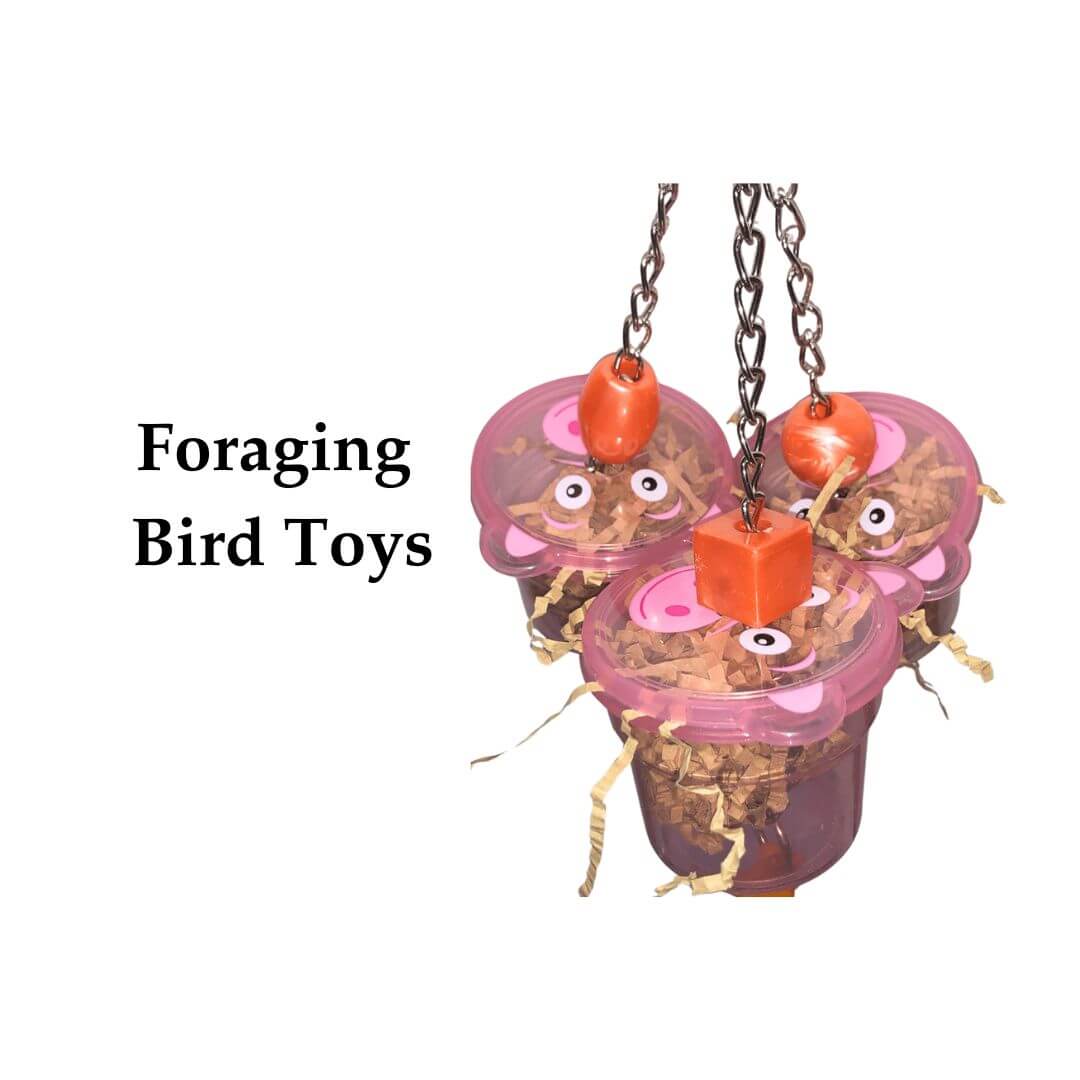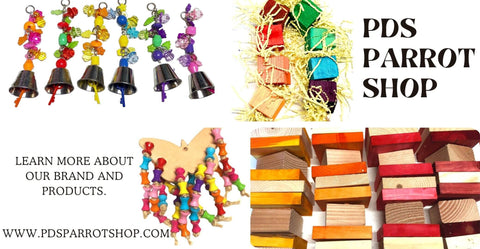
Foraging Bird Toys: Unleash the Fun and Exploring
Birds are fascinating creatures that bring joy and companionship to many households. However, as pet owners, we must ensure that our feathered friends receive proper mental and physical stimulation. One way to achieve this is by providing foraging bird toys. These toys not only keep birds entertained but also tap into their natural instincts, providing numerous benefits for their overall well-being. Shop Now: Foraging Bird Toys

Pin Me
One essential aspect of avian enrichment is the inclusion of foraging bird toys in their environment. In this article, we will explore the reasons why birds need foraging toys and how they contribute to their overall well-being. Want to learn about chew toys, foot toys, and safety tips too? Visit our comprehensive guide on bird toys

Introduction to Foraging Bird Toys
Foraging bird toys are specially designed items that encourage birds to engage in natural behaviors, mimicking the search for food in the wild. These toys are designed to challenge and stimulate birds' minds, providing them with a sense of purpose and fulfillment. By simulating the foraging process, we can help our pet birds stay mentally active and prevent boredom.
Benefits of Foraging Bird Toys
1) Mental Stimulation and Cognitive Development
Birds are highly intelligent creatures that require mental stimulation to thrive. Foraging toys offer an excellent opportunity for birds to exercise their problem-solving skills and enhance their cognitive abilities. By presenting birds with puzzles and challenges, foraging bird toys engage their cognitive abilities.
Just like humans, birds require mental stimulation to prevent boredom and maintain a healthy mindset. In the wild, birds spend a significant amount of time searching for food, which keeps their minds active and engaged. When birds are kept in captivity, it becomes crucial to replicate this natural foraging behavior to promote their mental well-being.
Birds must figure out how to access the hidden treats or navigate through the toy to find their reward. This mental stimulation reduces stress, and enhances their problem-solving skills. When presented with a foraging toy, birds must strategize and figure out how to access the hidden treats or rewards inside. This mental exercise promotes learning, memory retention, and overall cognitive development.
2) Physical Exercise and Well-being
Foraging bird toys encourage physical activity by requiring birds to move, climb, and manipulate objects. This exercise is vital for their overall health, as it helps them maintain a healthy weight, strengthens their muscles, and improves their motor skills.
In the wild, birds spend a significant amount of time and energy searching for food. By providing foraging toys, we encourage them to engage in physical activity similar to their natural foraging behaviors. As birds manipulate, explore, and solve puzzles presented by these toys, they engage in physical exercise that helps maintain their muscle tone, flexibility, and overall well-being.
Click Me!
3) Preventing Boredom and Behavior Problems
Birds are highly social creatures that thrive on stimulation and interaction with their environment. Without proper mental and physical engagement, they may become bored, leading to negative behaviors such as excessive vocalization, feather plucking, and aggression. Foraging bird toys provide a healthy outlet for their natural instincts, keeping them engaged and reducing the likelihood of behavior problems.
4) Encouraging Natural Behaviors with Foraging Bird Toys
Foraging is an instinctive behavior for birds, and by providing foraging bird toys, we allow them to engage in this natural behavior even in a captive environment. In the wild, birds have to work for their food by searching, exploring, and problem-solving. This natural foraging behavior helps keep their minds sharp and their bodies active.
When birds have the opportunity to display their innate behaviors, they experience a sense of fulfillment and contentment. By providing foraging bird toys, we can mimic these natural challenges and satisfy their innate desire to explore and search for food. Foraging bird toys also help prevent the development of undesirable habits, such as overeating or food aggression, as birds learn to associate food acquisition with a challenging and rewarding process.
5) Variety and Environmental Enrichment
Foraging bird toys come in a wide variety of shapes, sizes, and complexities, allowing you to provide your bird with an enriching and ever-changing environment. By introducing new and different foraging bird toys periodically, you prevent monotony and ensure continuous mental and physical stimulation. You can experiment with various designs, textures, and materials to keep your bird engaged and curious.
Foraging bird toys are an essential component of avian enrichment and play a crucial role in promoting the well-being of pet birds. By offering mental and physical challenges, foraging bird toys keep birds stimulated, prevent boredom, and encourage natural behaviors. Remember to provide a variety of toys to maintain interest and create an enriched environment for your feathered friend.

Types of Foraging Bird Toys
The market offers a wide range of foraging bird toys to cater to various species and sizes of birds. Let's explore some popular types:
Puzzle Toys
Puzzle toys are designed to challenge your bird's problem-solving skills. They usually consist of compartments, drawers, or hidden compartments where treats or small toys can be concealed. Birds must manipulate different parts of the toy to access the hidden rewards, providing mental stimulation and entertainment.
Foraging Balls
Foraging balls are hollow balls made from safe materials, with openings that allow birds to insert their beaks or claws to retrieve treats hidden inside. These toys encourage birds to engage in natural foraging behaviors and provide both mental and physical exercise.
Foraging Wheels
Foraging wheels consist of rotating or spinning parts that hide treats within them. Birds have to turn or spin the wheel to reveal the hidden rewards. This type of toy offers a dynamic and interactive experience for birds, stimulating their problem-solving abilities.
Treat Dispensers
Treat dispensers are interactive toys that release treats when manipulated correctly. Birds must learn how to manipulate levers, buttons, or slides to access their rewards. This type of toy provides both mental stimulation and physical exercise.
Shreddable Toys
Shreddable toys are made from materials such as paper, wood, or cardboard and are designed to be torn apart by birds. These toys cater to their natural instinct to shred, offering both mental stimulation and physical exercise. Birds can spend hours unraveling and exploring these toys, keeping them occupied and preventing boredom.

Choosing the Right Foraging Bird Toys
When selecting a foraging bird toys, several factors should be considered to ensure it is suitable for your feathered friend.
Safety
Ensure that the toy you choose is made from bird-safe materials, free from any toxic substances. Check out pdsparrotshop for safe, non-toxic foraging bird toys.
Size and Durability
The foraging bird toys should be appropriate for the size of your bird and made of sturdy materials that can withstand their beak strength.
Complexity Level
Choose a toy that suits your bird's size and skill level. Start with simpler foraging bird toys and gradually introduce more complex ones as your bird becomes familiar with the concept of foraging.
Safety Considerations
Inspect the toy for any sharp edges, loose parts, or potential hazards. Ensure that the materials used are non-toxic and bird-safe.

How to Introduce Foraging Bird Toys to Your Parrot
To maximize the effectiveness of foraging bird toys, it's important to introduce them properly to your bird.
Gradual Introduction
Start by placing the toy near your bird's cage to allow them to become familiar with it. Once they show interest, hang or attach the toy to their cage within easy reach.
Using Treats as Incentives
To encourage your bird to interact with the toy, place some treats or food rewards inside. This will motivate them to explore and engage with the toy.

DIY Foraging Bird Toys
Creating your own foraging bird toys can be a fun and cost-effective way to provide enrichment for your feathered friend. Here are some simple ideas:
Cardboard Boxes and Tubes
Empty cardboard boxes and tubes can be filled with treats or food and sealed with tape. Birds will have to chew and shred the cardboard to access their rewards.
Paper Roll Treat Holders
Save paper towels or toilet paper rolls and fold one end closed. Fill the roll with treats and fold the other end closed. Birds can chew and unravel the roll to get to the treats.
Fruit Kabobs
Thread small pieces of bird-safe fruits onto a skewer or bird-safe kabob toy. Birds will enjoy picking the fruit and working to get their reward.
Tips for Maximizing the Effectiveness of Foraging Bird Toys
To ensure your bird receives maximum benefit from foraging bird toys, consider the following tips:
Rotating Toys
Introduce different toys and rotate them regularly to keep your bird's interest high. This prevents them from getting bored with a single toy and encourages continued engagement.
Varying the Food Rewards
Use a variety of treats or food rewards to maintain your bird's curiosity and interest. Experiment with different textures, flavors, and sizes to keep them engaged.
Monitoring and Supervision
Always supervise your bird while they interact with foraging bird toys. This ensures their safety and allows you to observe their enjoyment and progress.
Try these easy DIY Foraging bird toy idea.
Frequently Asked Questions (FAQs)
-
Q: How often should I rotate foraging bird toys?
A: It's recommended to rotate the toys every week to keep your bird's interest and engagement levels high.
-
Q: Can foraging bird toys help with feather plucking?
A: Foraging bird toys can be beneficial in reducing feather plucking by providing mental stimulation and preventing boredom.
-
Q: Are there specific treats I should use with foraging bird toys?
A: It's important to use bird-safe treats such as fresh fruits, vegetables, nuts, or commercially available bird treats that are suitable for your bird's diet.
- Q: Can foraging bird toys be used for all bird species?
-
A: Foraging bird toys are suitable for various bird species, but it's important to choose toys that are appropriate for the size and capabilities of your specific bird.
-
Q: How can I ensure the safety of DIY foraging toys?
A: When creating DIY foraging bird toys, use non-toxic materials. Monitor your bird's interaction with the toy to ensure safety.
Conclusion
Incorporating foraging bird toys into your pet bird's environment is a wonderful way to provide mental stimulation, physical exercise, and behavioral enrichment. By selecting the right toys and introducing them gradually, you can enhance your bird's overall well-being and contribute to their happiness. So, why wait? Invest in foraging bird toys today and watch your feathered friend thrive in an engaging and stimulating environment.
More Articles on Bird Toys
Author: Monika Sangar
Co-founder of Prego Dalliance Sanctuary, Artisan of PDS Parrot Shop
Monika Sangar, the co-founder of Prego Dalliance Sanctuary, a 501c3 non-profit organization, uses these blogs to share her hands-on experience with parrots.
She is a designer and artisan at PDS Parrot Shop, and her craft can be viewed below. (click on logo)
PDS is a registered 501(c)3 nonprofit organization (tax id #46-2470926) PDS parrot shop makes parrot toys to help fund our sanctuary, Prego Dalliance sanctuary, 501c3, non-profit. www.pdsnonprofit.org

